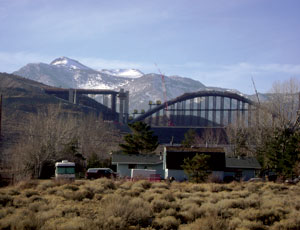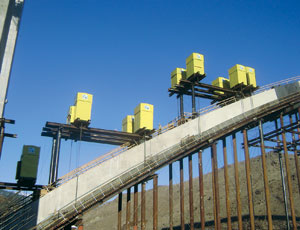Construction engineers finishing up the country’s longest cathedral-arch bridge in a tough, rocky patch of northern Nevada say they have found a new way to capitalize on the slow-and-steady power that strand jacks provide.


C.C. Myers Inc., Rancho Cordova, Calif., is using a dozen of the 85-ton jacks fabricated by Milwaukee, Wis.-based Enerpac to lower falsework for the 1,722-ft-long Galena Creek Bridge. The project is part of the $393.3-million final leg of an 8.5-mile Interstate 580 extension between Reno and Carson City being built by Dickinson, N.D.-based general contractor Fisher Sand & Gravel Co. The 295-ft-tall, cast-in-place concrete and steel-reinforced bridge consists of two parallel, 62-ft-wide, three-lane structures with 689-ft-long center spans.
On the job, conventional concrete falsework was too heavy for traditional cables and winches. Strand jacks, by contrast, uniformly grab, lift and lower cables through hollow centers at 12 points, avoiding cocking and uneven stress. The jacks trade speed for precision. Unlike winches, they permit programmable lowering lengths and speeds with complete movement control, uniformly or independent of one another. The system also enables load monitoring. Suspended loads average 110,000 lbs. per jack, with lowering speeds of up to 60 ft per hour.
“Typically, strand jacks are used for moving bridge-deck girders and post-tensioning,” says Floyd Engelking, an Enerpac engineer. “This is a much smaller application that gives the user position and movement control to make sure the load is safely transported.”
For Galena Creek, the jacks hang off the bridge itself. The Nevada Dept. of Transportation mandated that no holes could be drilled into the roadway deck. By contrast, most projects have smaller bridge widths and permit holes in the median and overhangs, says Bill Kidwell, C.C. Myers engineering manager. Falsework is assembled piecemeal on the creek floor and erected into place using cranes—but cranes cannot reach around the structure once built. Enter the jacks.
Each jack is electronically controlled with built-in sensors for “closed-loop” operation, then networked to a digital touch-screen controller that has stroke and load readouts and alarms. The system’s modular architecture allows up to 32 jacks to be controlled with one controller. Movement is synchronized within 0.04 inches between leading and lagging jacks during lowering.
C.C. Myers designed and fabricated steel enclosures that house a 15-hp electric-over-hydraulic supply and cable coiler that are all powered by an on-site generator. These enclosures also protect against the elements. C.C. Myers sent two employees to Enerpac’s factory to learn the jacking system’s programmable computer and operational controls, as it was the first time the 32-year-old infrastructure contractor used strand jacks in this way.
The specialized jacking method is helping the tough project near completion. Edward Kraemer & Sons Inc., Plain, Wis., began construction of the Galena Creek Bridge but left the job in 2006 at 40% completion over disputes arising from NDOT’s mandated cast-in-place pilot-truss bridge erection method. The sequence called for bolting and welding 18 steel segments together to create a structural framework for wrapping rebar and concrete around trusses to form the arch. Kraemer felt it was unfeasible; Fisher and their bridge subcontractor, C.C. Myers, feel the same way. The duo was hired in November 2006 to finish construction.
Instead of using the original plans, they are temporarily raising the creek floor by 140 ft using 450,000 cu meters of compacted soil placed with five conveyor belts, 54 in. wide by 225 ft long. Next, they created a 44-ft-dia, 22-ft-tall, 3-ft-thick temporary bridge arch with shotcrete reinforced with up to size-12 rebar. A custom-fabricated interior slip-form enables 40-ft sectional pours.
“When you get up that high, there is no other way to do it,” Fisher Nevada manager Joseph Miller says. The erection method shaved 100 days from the 1,000-day schedule. The project is about 51% done and scheduled to finish in fall 2011. Says Kidwell, “It would have been challenging to do this project without this jacking system.”


Post a comment to this article
Report Abusive Comment